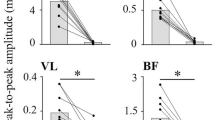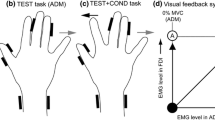Abstract
It is well known that monosynaptic spinal reflexes and motor evoked potentials following transcranial magnetic stimulation (TMS) are reinforced during phasic and intensive voluntary contraction in the remote segment (remote effect). However, the remote effect on the cortical silent period (CSP) is less known. The purpose of the present study is to determine to what extent the CSP in the intrinsic hand muscle following TMS is modified by voluntary ankle dorsiflexion and to elucidate the origin of the modulation of CSP by the remote effect. CSP was recorded in the right first dorsal interosseous while subjects performed phasic dorsiflexion in the ipsilateral side under self-paced and reaction-time conditions. Modulation of the peripherally-induced silent period (PSP) induced by electrical stimulation of the ulnar nerve was also investigated under the same conditions. In addition, modulation of the CSP was investigated during ischemic nerve block of the lower limb and during application of vibration to the tibialis anterior tendon. The duration of CSP was significantly shortened by phasic dorsiflexion, and the extent of shortening was proportional to dorsiflexion force. Shortening of the CSP duration was also observed during tonic dorsiflexion. In contrast, the PSP duration following ulnar nerve stimulation was not altered during phasic dorsiflexion. Furthermore, the remote effect on the CSP duration was seen during ischemic nerve block of the lower limb and the pre-movement period in the reaction-time paradigm, but shortening of the CSP was not observed during tendon vibration. These findings suggest that phasic muscle contraction in the remote segment results in a decrease in intracortical inhibitory pathways to the corticospinal tract innervating the muscle involved in reflex testing and that the remote effect on the CSP is predominantly cortical in origin.





Similar content being viewed by others
References
Boroojerdi B, Battaglia F, Muellbacher W, Cohen LG (2000) Voluntary teeth clenching facilitates human motor system excitability. Clin Neurophysiol 111:988–993
Chen R, Lozano AM, Ashby P (1999) Mechanism of the silent period following transcranial magnetic stimulation. Exp Brain Res 128:539–542
Cheney PD, Fetz EE (1980) Functional classes of primate corticomtoneuronal cells and their relation to active force. J Neurophysiol 44:773–791
Davey NJ, Romaiguère P, Maskill DW, Ellaway PH (1994) Suppression of voluntary motor activity revealed using transcranial magnetic stimulation of the motor cortex in man. J Physiol 477:223–235
Day BL, Rothwell JC, Thompson PD, Dick JP, Cowan JM, Berardelli A, Marsden CD (1987) Motor cortex stimulation in intact man 2. Multiple descending volleys. Brain 110:1191–1209
Delwaide PJ, Toulouse P (1981) Facilitation of monosynaptic reflexes by voluntary contraction of muscles in remote parts of the body. Brain 104:701–719
Dowman R, Wolpaw J (1988) Jendrassik maneuver facilitates soleus H-reflexes without change in average soleus motoneuron pool membrane potential. Exp Neurol 101:288–302
Foltys H, Meister IG, Weidemann J, Sparing R, Thron A, Willmes K, Töpper R, Hallett M, Boroojerdi B (2003) Power grip disinhibits the ipsilateral sensorimotor cortex: a TMS and fMRI study. NeuroImage 19:332–340
Fuhr P, Agostino R, Hallett M (1991) Spinal motor neuron excitability during the silent period after cortical stimulation. Electroencephalogr Clin Neurophysiol 81:257–262
Furubayashi T, Sugawara K, Kasai T, Hayashi A, Hanajima R, Shiio Y, Iwata NK, Ugawa Y (2003) Remote effects of self-paced teeth clenching on the excitability of hand motor area. Exp Brain Res 148:261–265
Gilio F, Rizzo V, Siebner HR, Rothwell JC (2003) Effects on the right motor hand-area excitability produced by low-frequency rTMS over human contralateral homologous cortex. J Physiol 551:563–573
Gross J, Pollok B, Dirks M, Timmermann L, Butz M, Schnitzler A (2005) Task-dependent oscillations during unimanual and bimanual movements in the human primary motor cortex and SMA studied with magnetoencephalography. NeuroImage 26:91–98
Hess CW, Mills KR, Murray NMF (1987) Responses in small hand muscles from magnetic stimulation of the human brain. J Physiol 388:297–419
Hess A, Kunesch E, Classen J, Hoeppner J, Stefan K, Benecke R (1999) Task-dependent modulation of inhibitory actions within the primary motor cortex. Exp Brain Res 124:321–330
Hortobágyi T, Taylor JL, Pertersen NT, Russell G, Gandevia SC (2003) Changes in segmental and motor cortical output with contralateral muscle contractions and altered sensory inputs in humans. J Neurophysiol 90:2451–2459
Inghilleri M, Berardelli A, Cruccu G, Manfredi M (1993) Silent period evoked by transcranial stimulation of the human cortex and cervicomedullary junction. J Physiol 466:521–534
Jendrássik E (1883) Beitäge zur lehre von den sehnenreflexen. Dtsch Arch Klin Med 33:177–199
Kagamihara Y, Hayashi A, Masakado Y, Kouno Y (2003) Long-loop reflex from arm afferents to remote muscles in normal man. Exp Brain Res 151:136–144
Kawakita H, Kameyama O, Ogawa R, Hayes KC, Wolfe DL, Allatt RD (1991) Reinforcement of motor evoked potentials by remote muscle contraction. J Electromyogr Kinesiol 1:96–106
Mathis J, de Quervain D, Hess CW (1998) Dependence of the transcranially induced silent period on the ‘instruction set’ and the individual reaction time. Electroencephalogr Clin Neurophysiol 109:426–435
Miyahara T, Hagiya N, Ohyama T, Nakamura Y (1996) Modulation of human soleus H reflex in association with voluntary clenching of the teeth. J Neurophysiol 76:2033–2041
Muellbacher W, Facchini S, Boroojerdi B, Hallett M (2000) Changes in motor cortex excitability during ipsilateral hand muscle activation in humans. Clin Neurophysiol 111:344–349
Péréon Y, Genet R, Guihéneuc P (1995) Facilitation of motor evoked potentials: timing of Jendrasik maneuver effects. Muscle Nerve 18:1427–1432
Rothwell JC, Thompson PD, Day BL, Boyd S, Marsden CD (1991) Stimulation of the human motor cortex through the scalp. Exp Physiol 76:159–200
Sohn YH, Kang SY, Hallett M (2005) Corticospinal disinhibition during dual action. Exp Brain Res 162:95–99
Sugawara K, Furubayashi T, Takahashi M, Ni Z, Ugawa Y, Kasai T (2005) Remote effects of voluntary teeth clenching on excitability changes of the human hand motor area. Neurosci Lett 377:25–30
Takada Y, Miyahara T, Tanaka T, Ohyama T, Nakamura Y (2000) Modulation of H reflex of pretibial muscles and reciprocal Ia inhibition of soleus muscle during voluntary teeth clenching in humans. J Neurophysiol 83:2063–2070
Taylor JL, Allen GM, Butler J, Gandevia SC (1997) Effect of contraction strength on responses in biceps brachii and adductor pollicis to transcranial magnetic stimulation. Exp Brain Res 117:472–478
Tazoe T, Kida T, Wasaka T, Sakamoto M, Nakajima T, Nishihira Y, Komiyama T (2005) Attenuation of the effect of remote muscle contraction on the soleus H-reflex during plantar flexion. Clin Neurophysiol 116:1362–1369
Tinazzi M, Farina S, Tamburin S, Facchini S, Fiaschi A, Restivo D, Berardelli A (2003) Task-dependent modulation of excitatory and inhibitory functions within the human primary motor cortex. Exp Brain Res 150:222–229
Triggs WJ, Cros D, Macdonell RAL, Chiappa KH, Fang J, Day BJ (1993) Cortical and spinal motor excitability during the transcranial magnetic stimulation silent period in humans. Brain Res 628:39–48
Turton A, Lemon RN (1999) The contribution of fast corticospinal input to the voluntary activation of proximal muscles in normal subjects and in stroke patients. Exp Brain Res 129:559–572
Vallbo ÅB (1971) Muscle spindle response at the onset of isometric voluntary contraction in man. Time difference between fusimotor and skeletomotor effects. J Physiol 318:405–431
Wasaka T, Nakata H, Kida T, Kakigi R (2005a) Changes in the centrifugal gating effect on somatosensory evoked potentials depending on the level of contractile force. Exp Brain Res 166:118–125
Wasaka T, Nakata H, Kida T, Kakigi R (2005b) Gating of SEPs by contraction of the contralateral homologous muscle during the preparatory period of self-initiated plantar flexion. Brain Res Cogn Brain Res 23:354–360
Wassermann E, Pascual-Leone A, Valls-Sole J, Toro C, Cohen LG, Hallett M (1993) Topography of inhibitory and excitatory responses to transcranial magnetic stimulation in a hand muscle. Electroencephalogr Clin Neurophysiol 89:424–433
Wilson SA, Lockwood RJ, Thickbroom GW, Mastaglia FL (1993) The muscle silent period following transcranial magnetic cortical stimulation. J Neurol Sci 114:216–222
Wu L, Goto Y, Taniwaki T, Kinukawa N, Tobimatsu S (2002) Different patterns of excitation and inhibiiton of the small hand and forearm muscle from magnetic brain stimulation in humans. Clin Neurophysiol 113:1286–1294
Zehr EP, Stein RB (1999) Interaction of the Jendrássik maneuver with segmental presynaptic inhibition. Exp Brain Res 124:474–480
Zehr EP, Frigon A, Hoogenboom N, Collins DF (2004) Facilitation of soleus H-reflex amplitude evoked by cutaneous nerve stimulation at the wrist is not suppressed by rhythmic arm movement. Exp Brain Res 159:382–388
Ziemann U, Netz J, Szelenyi A, Homberg V. (1993) Spinal and supraspinal mechanisms contribute to the silent period in the contracting soleus muscle after transcranial magnetic stimulation of human motor cortex. Neurosci Lett 156:167–171
Author information
Authors and Affiliations
Corresponding author
Rights and permissions
About this article
Cite this article
Tazoe, T., Endoh, T., Nakajima, T. et al. Disinhibition of upper limb motor area by voluntary contraction of the lower limb muscle. Exp Brain Res 177, 419–430 (2007). https://doi.org/10.1007/s00221-006-0686-1
Received:
Accepted:
Published:
Issue Date:
DOI: https://doi.org/10.1007/s00221-006-0686-1




